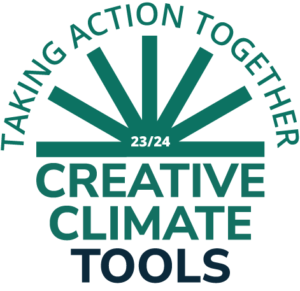Executive Summary
Climate change is here. It is already affecting our lives and those of our communities. Arts Council England’s National Portfolio Organisations (NPOs) recognise this and are taking bold steps towards environmental responsibility, finding creative ways to take action together.
In this report we’ll share inspiring examples from across the sector alongside environmental reporting results from the first year of the new portfolio (2023-26). Analysis of the self-reported data, carbon impacts, and environmental measures submitted by 591 organisations provides a clear snapshot of where the creative and cultural sector stands today.
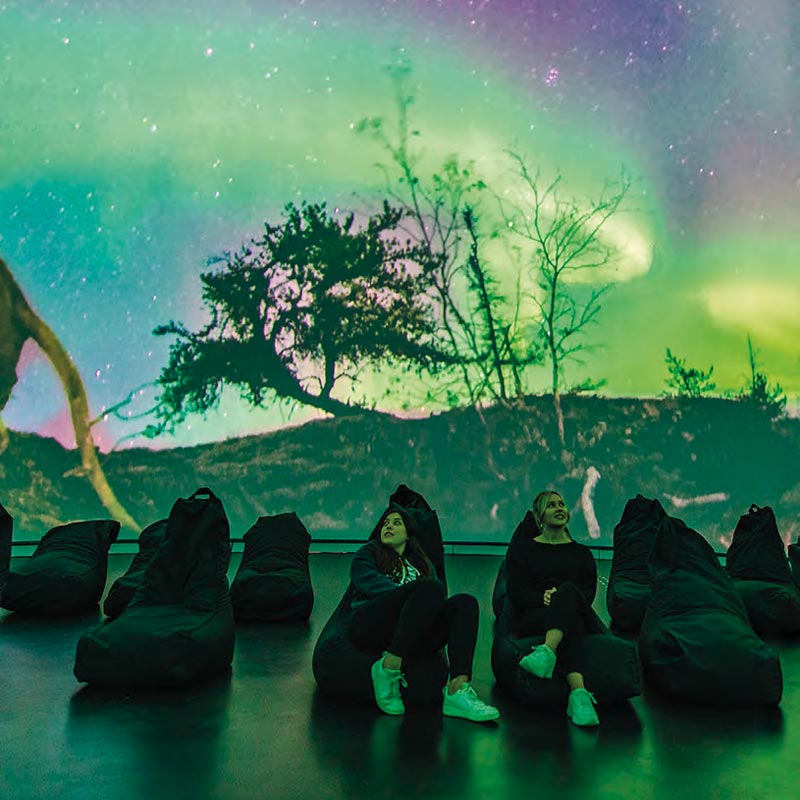
Environmental data gathered from Julie’s Bicycle’s Creative Climate Tools (CC Tools) indicates that waste1 has surged to the forefront as a major contributor of indirect emissions2 .
In addition to taking action on their measured carbon impacts, the sector is using its influence to engage audiences and stakeholders with environmental action. Many organisations are exploring environmental themes through their exhibitions, shows, events and educational activities. Biodiversity is getting a boost too, with organisations planning programmes and events that focus on nature and using outside space to help bring environmental awareness into the spotlight.
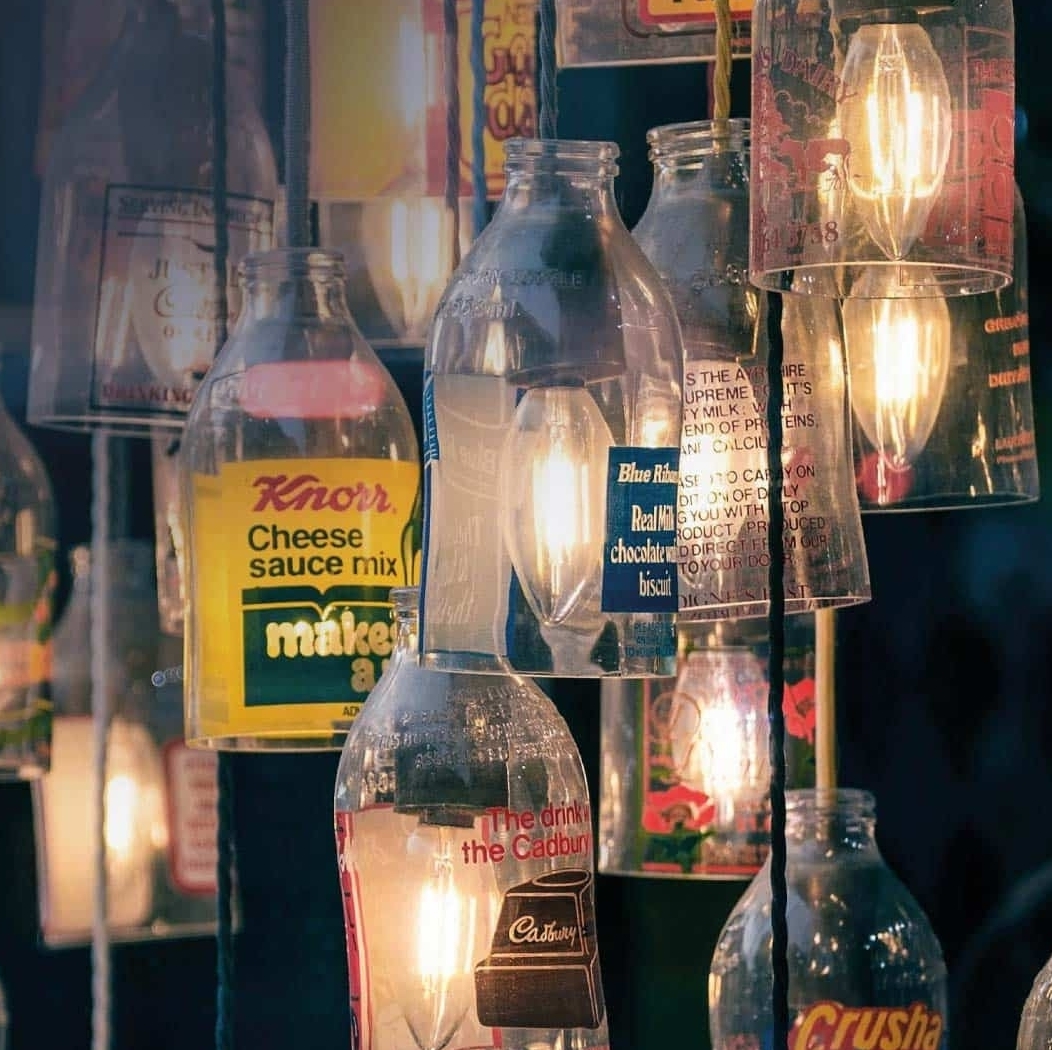
Organisations are not just talking the talk – they’re embedding sustainability into their very core, appointing environmental champions to their governance boards, integrating environmental considerations into policies, developing green riders, training staff, and sharing knowledge with their peers. Reporting shows that this has led to rewards such as boosts in team morale, financial benefits and funding opportunities.
The path ahead is challenging, but with active collaboration and resource sharing, the sector is building confidence and making tangible progress toward decarbonisation and sustainability. The push for a greener future is on, and the creative and cultural sector is leading the charge.
1 For further information please see ‘Waste methodology & conversion factor update – FAQs’, on the Resources Page of the CC Tools.
2 Indirect emissions, known as known as scope 3 emissions, also include audience travel, staff travel, and emissions from suppliers.
Introduction
Since its launch in 2012 in partnership with Julie’s Bicycle, the Environmental Programme has continued to evolve, driving action and embedding environmental leadership into the fabric of our cultural community.
The Programme is packed with resources, tools and training to support the diversity required across the sector. In addition, cultural organisations are also invited to join free development programmes that focus on decarbonisation, resilience, justice and governance.
-
For building-based organisations the Transforming Energy programme is made up of two strands:
- Building Net Zero Energy (BNZE) for organisations at the beginning of their environmental journey and looking for additional support to ramp up their efforts. This strand offers free self-service resources, expert support from Pilio (Julie’s Bicycle’s technical partners), and training in energy management.
- Capital Investment Ready provides enhanced support to organisations advancing their environmental commitments, assisting them in preparing a key cultural venue for electrification and focusing on 2030 decarbonisation goals.

-
Supporting trustees and board members of NPOs and IPSOs, the Board Environmental Champions programme provides training, resources and a valuable peer network, which enables knowledge sharing, skills and confidence building to embed environmental responsibility within organisations at board level.

-
Leading Resilience is a new discovery and mentoring programme that will support and cultivate leadership across the portfolio and wider sector, developing an understanding of adapting and building resilience to climate impacts through practical support and upskilling. This programme has two strands:
- Adapting Culture offers bespoke webinars for leaders to support a focus on incorporating adaptation thinking into governance and policy for NPOs and IPSOs, with an additional series of workshops open to the wider sector to build an understanding of adaptation to climate change in the context of place-making, nature and biodiversity, and venues.
- Resilient Horizons programme is a collaboration with Arts Council England’s Creative People and Places programme which will focus on supporting action on adaptation and towards resilience for place-based, creative community-led action, with a deepening focus on one city, town or rural setting in 2025.

-
The Creative Climate Accelerator programme is targeted at people from diverse backgrounds and underrepresented groups. It allows an individual, nominated by a supporting NPO or IPSO, access to a free six-part online training programme designed to equip them with skills and understanding so that they can act as agents of change within the sector.

-
Through Creating Now for the Future, Julie’s Bicycle are collaborating with individual practitioners to co-design a
comprehensive new suite of environmental resources. They are designed specifically to support freelance artists, creatives and freelancers.
Carbon Snapshot
Of 985 organisations, 5913 NPOs (60%) reported on 2023-24, the 2023-26 portfolio’s first year of reporting.
Organisations self-reported their data across several different environmental impact areas including Artist/Crew Travel, Audience Travel, Business Travel, Energy, Fleet Travel, Freight Travel, Materials, Show Power, Waste, Water and Sewerage.
The total emissions from the reporting portfolio are 84,561 tCO2e
Audience data is reported separately. If audience travel were included this year, this would account for 42% of the total carbon footprint of the portfolio, with total portfolio emissions reaching 144,584 tCO2e.

0
tonnes of waste4

0.0 billion
litres of water reported6

Touring 5
0.0 million km

Business travel
0 million km

Total emissions
0 tCO2e

Total electricity
0 million kWh

Total gas
0 million kWh
Total energy
0 million kWh

Enough to power
0
UK households7

Total energy spend 8
£ 0.0 million
3 There were a total of 610 organisations reporting, however 19 were excluded from the database due to inaccuracies in input data, double counting and anomalous figures
4 A total of 377 NPOs reported waste data (38% of the total portfolio)
5 Touring distance includes Artist/Crew travel and Freight Travel
6 A total of 410 NPOs reported water use (42% of the total portfolio)
7 Based on annual average household energy usage of 14,200 kWh, source here
8 Figure DOES NOT include diesel, oil and district heating figures
Total emissions by sector: 84,561
Emissions tCO2e
Total emissions per impact area: 84,561
Emissions tCO2e
There were 339 organisations who reported data for home working in 2023-24, and their energy usage amounts to 1% of the total energy usage or 1.2% of the total emissions.
There were 56 organisations that submitted additional data within the new custom emission11 tabs, This represents 10% of the total number of organisations reporting custom data and the emissions total 2,797 CO2e emissions.
9 Including – Archives, circus, cross sector support, cultural, outdoor arts, screen industries, and non-sector specific.
10 This total figure includes the custom emission figures.
11 ‘Custom Emissions’ is where users can directly input already calculated carbon emissions (i.e. from other tools) into the Creative Climate Tools. This data is treated separately because other tools may use different conversion factors, which means that it is not directly comparable to direct entries on the Creative Climate Tools.
Audience Travel
This year the reported emissions from audience travel totals 60,023 tCO2e, with car travel being the highest emitting mode of transport.

Car travel
0 million tCO2

Train travel
0.0 million tCO2

Local buses
0.0 million tCO2
This impact area poses significant challenges for environmental reporting due to its inherent complexity and diversity. The variety of transport modes and regional differences makes calculating accurate emissions tricky, and it is more challenging for data from unticketed events to be tracked. To address the complexity of data collection, organisations have focused on promoting sustainable travel options, offering virtual event alternatives, improving data collection methods, and regularly monitoring and reporting their emissions.
We are tracking Audience Travel separately from the rest of the data, as reporting on this is likely to change over time. This year 250 organisations added audience travel data, 16 of whom used the custom emissions functionality.
If this data were added to the total results this year, audience travel alone would account for 42% of the total carbon footprint of the portfolio, with total portfolio emissions reaching 144,584 tCO2e.
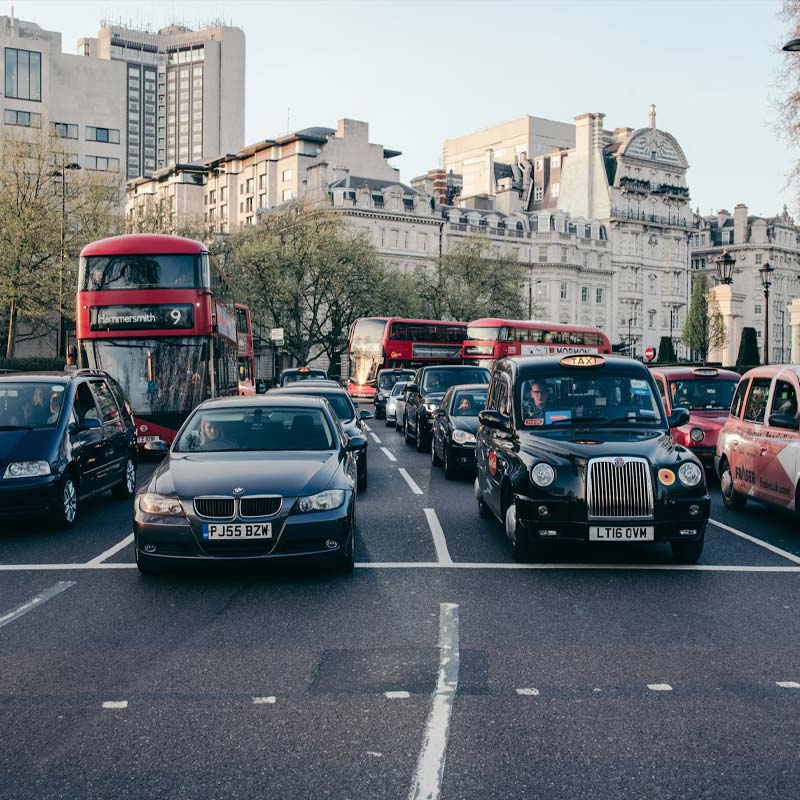
Total emissions per method of travel in Audience Travel
| Method of travel | Emissions tCO2e |
| Car | 30,009,796 |
| Train | 21,950,018 |
| Bus Local12 | 2,217,288 |
| Domestic Flights | 1,669,641 |
| Long Haul Flights | 1,052,227 |
| Public Transport Bus Urban13 | 1,049,877 |
| Tube | 741,148 |
| Short Haul Flights | 621,160 |
| Taxi Travel | 442,209 |
| Dedicated Coaches | 134,232 |
| Custom Emissions | 114,474 |
| Ferry | 21,169 |
| Total | 60,023,239 |
12. Short distance bus travel to venue
13. Non-chartered long distance bus travel (not incl shuttle bus travel to venue)
Carbon – Key Insights
Energy is the most significant impact area reported on by the portfolio, accounting for 54% total reported emissions. Of these energy-related emissions, 80% were generated by 16% of organisations in the portfolio.
In addition to being a major contributor to emissions, rising energy costs in recent years have prompted organisations to review their energy contracts and bills more closely, leading to increased adoption of LED lighting and energy-saving measures, supported by increased awareness at senior management levels.
There is growing interest in investing in renewable energy despite logistical challenges, with organisations looking to install solar panels for roof spaces, though some early adopters now require re-installations as technology has improved. There is a shift towards electrification as organisations aim to meet their net zero targets, with a broader exploration of district heating14 networks, including the Greater London Authority commissioning work to develop strategic approaches for closely clustered cultural buildings.
Overall, cultural organisations continue to face challenges due to the limited experience renewable energy installers have with cultural buildings. Limited control over energy efficiency due to leasing buildings or space poses a further challenge, particularly for smaller organisations.
Engagement with the Buildings Net Zero Energy programme has shown sector-wide interest in sustainability, specifically energy efficiency and decarbonisation of buildings, but also highlighted challenges in implementation due to bandwidth, resources and ongoing issues regarding clarity of roles and responsibilities.
Across the whole programme peer sharing and resources have been beneficial for organisations in improving their energy efficiency, with many organisations making significant progress and becoming more confident in their sustainability efforts.
14 District heating is a system generating heat in a central location and distributing it to nearby residents, businesses and industry in the local area.
Energy
0 %
(total reported emissions)

Waste
0 %
(total reported emissions)

Travel
0 %
(total reported emissions)
Associated with the upgrading of the Creative Climate Tools methodology, waste has emerged as a significant source of emissions in comparison to previous years, accounting for 28% total reported emissions.
This is because waste and materials now include upstream emissions (i.e. associated with the creation and generation of materials), while in contrast, energy emissions reporting remains focused only on consumption, excluding upstream factors. Many organisations will have seen an increase in the contribution of waste to their carbon footprints, highlighting the need for closer scrutiny of scope 3 emissions.
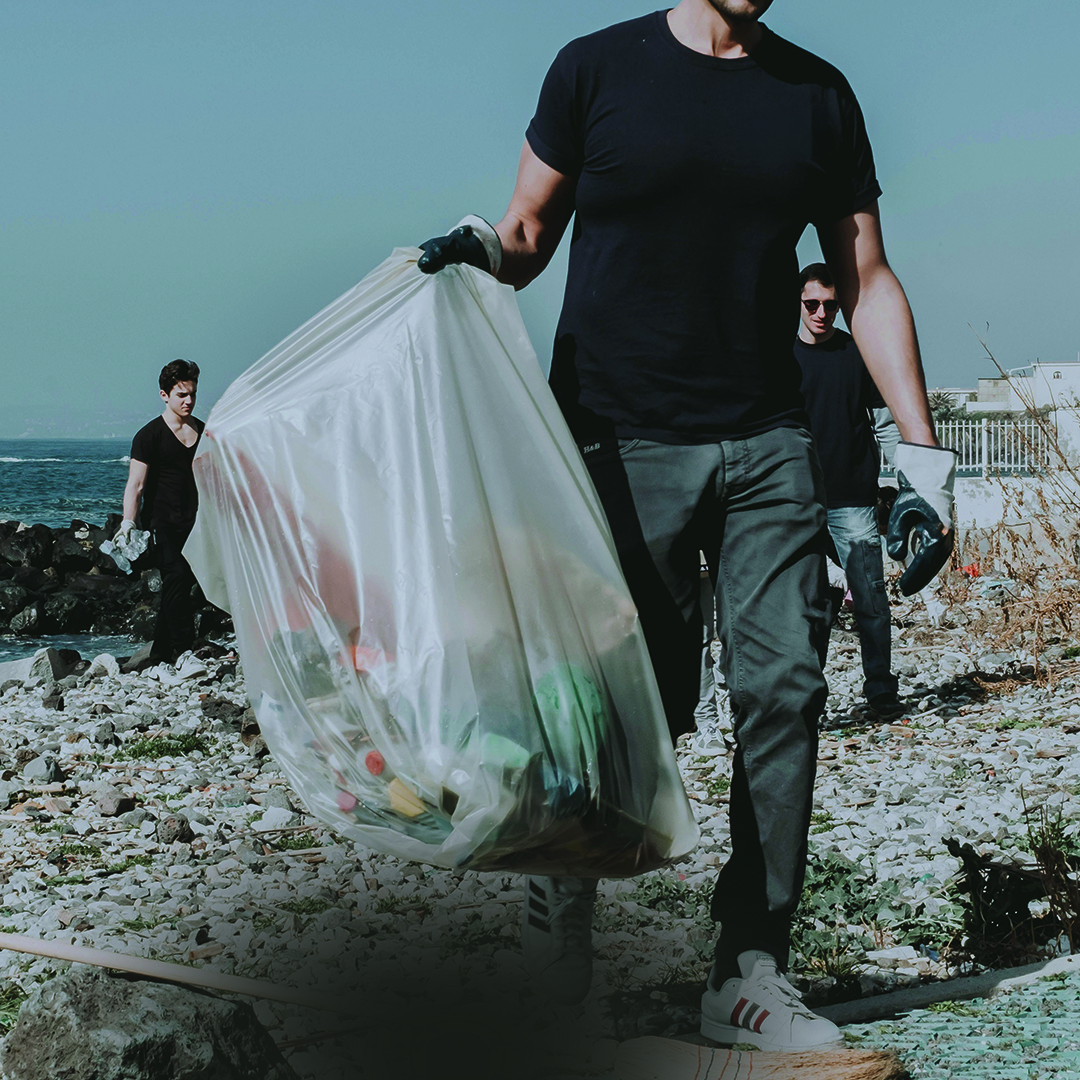
Travel is the next largest impact area, with artist and crew travel, business travel and freight totalling 16% of overall emissions reported. For tours, most travel emissions (80%) are associated with artist and crew travel alone.
Water usage amounted to 1,557,867 m³, with two thirds of associated emissions attributed to consumption and treatment processes contributing a third.
Large organisations contribute significantly to overall emissions, but it is worth noting that medium-sized organisations make up 3% of reporting organisations and disproportionately emit 36% of total emissions.15 These findings highlight the potential benefits of targeting sustainability initiatives – and opportunities for capital investment upgrades – towards these organisations. Overall, the majority of emissions are generated within the most represented sectors: museums, combined arts, theatres, music and visual arts.
15. For the purposes of this report, and in the Creative Climate Tools, small organisations have fewer than 50 FTE employees, medium fewer than 250, and large over 250. The data, sourced from the Creative Climate Tools, is self-reported, so it may contain inaccuracies due to human error or outdated information.
I am a theatre director and change-maker and have been involved in executive and trustee leadership in the cultural sector across a range of organisations including the Belgrade Theatre, Coventry City of Culture, the Royal Shakespeare Company and Birmingham Opera Company.
Thanks to my Surinamese heritage I also worked in the Caribbean for six years, which was formative in centring equity and sustainability in my cultural practice. In working with cultural groups across Suriname’s diverse communities, I built an understanding of the community, spiritual and pedagogical origins of performance, often rooted in a close relationship with the natural world.
In working across theatre making and economic development with communities in the rainforest, government departments and international organisations, I learnt the essential nature of embedding grass roots voices at the heart of national and global dialogue for strategic progress. Whilst working in the most forested country in the world, with an economy dependent on mining, I saw how extraction economies follow the patterns of colonial plantation economies, continuing to service the material demands of the West, whilst erasing Indigenous relations with the natural environment.
To put it simply, Capitalist systems foreground financial value, and so define the natural world as commodity rather than partner. Financial pressures in the UK are similarly pushing the cultural sector to commodify artistic outputs, taking us further away from our communities, our community purpose and from connection with our environment.
Centring climate justice means centring social responsibility and dialogue with communities to create a working model that is environmentally and financially sustainable, and socially equitable.

Boards must lead our response to the climate crisis with a radical change in values, not simply by reducing carbon footprints. Governance tools can centre community, equity and climate by:
- Creating a clear strategy for board recruitment/induction/development so that all feel empowered to bring their best selves, and discussions combine experience with fresh insight
- Ensuring there are a range of voices around the board table, including from community contexts, with a chair who is a facilitator of those voices, supporting trustees to sit with difficulty, disagree well and be open to new ideas
- Giving a seat to Nature at the board table (suggested by Kate Raworth), with all trustees considering Her contributions
- Ensuring clear structures for community cocreation across the business plan, with clear goal setting, milestones and monitoring systems – and holding leadership to account at meetings.
Boards also need to recruit artistic and executive directors to a new model of leadership – not the individual hero leader of old, but leaders who are collaborators, facilitators and connectors. They need to be able to think long term, with the flexibility and responsiveness to change direction; be comfortable not knowing all the answers; centre models of co-creation in artistic programming and organisational structure; understand the interplay of excellence and resonance; make brave choices in a difficult climate; and hold the complexities of a global perspective. This would allow the arts to do what they do best – build community, learning and connection with each other and our environment – as well as modelling the new ways of leading and collaborating that our world so sorely needs.
Justine has participated in Board Environmental Champions – a programme that provides training, resources and a peer network to help NPOs and IPSOs embed environmental responsibility at board level.
Beyond Carbon Snapshot
This year, 226 organisations completed the survey, representing 38% of those submitting environmental data.
Have an environmental policy
Have an environmental action plan
Good Governance
Make environmental principles and values central to core business strategies
Have a dedicated budget for environmental initiatives
Have appointed a member of their Governance group or Board, to oversee environmental progress
Regularly discuss environmental data and progress on environmental responsibility at senior management level
Are changing activities and programmes to adapt to a changing climate
Operational Practice
Use environmental data to review and update action plans and target setting
Procure renewable energy through a green energy tariff
Have taken steps to save energy and be more energy efficient
Programming
Include environmental sustainability in artistic/production briefs and open calls
Have produced/programmed/curated work exploring environmental themes within the last year
Engagement, Collaboration and Communication
Gather feedback about environmental actions and initiatives to understand their influence and impact
Actively collaborate with other cultural organisations to find and share solutions to environmental issues
Benefits and Value
Have experienced direct financial benefits
Have attracted new or increased audiences and visitors through environmental activities or programming
Have experienced profile/reputational benefits
Have experienced team morale/well-being benefits
Have used environmental policies when making applications for funding
Other practical steps that organisations are taking include:
75% communicate and promote public transport options for travel to/from their organisation
53% have a staff travel policy that promotes low or zero-carbon travel
66% choose materials and methods which are environmentally more sustainable
74% recycle their production/ exhibition materials and re-use or re-purpose materials onsite
34% are greening their spaces to promote nature and wellbeing benefits
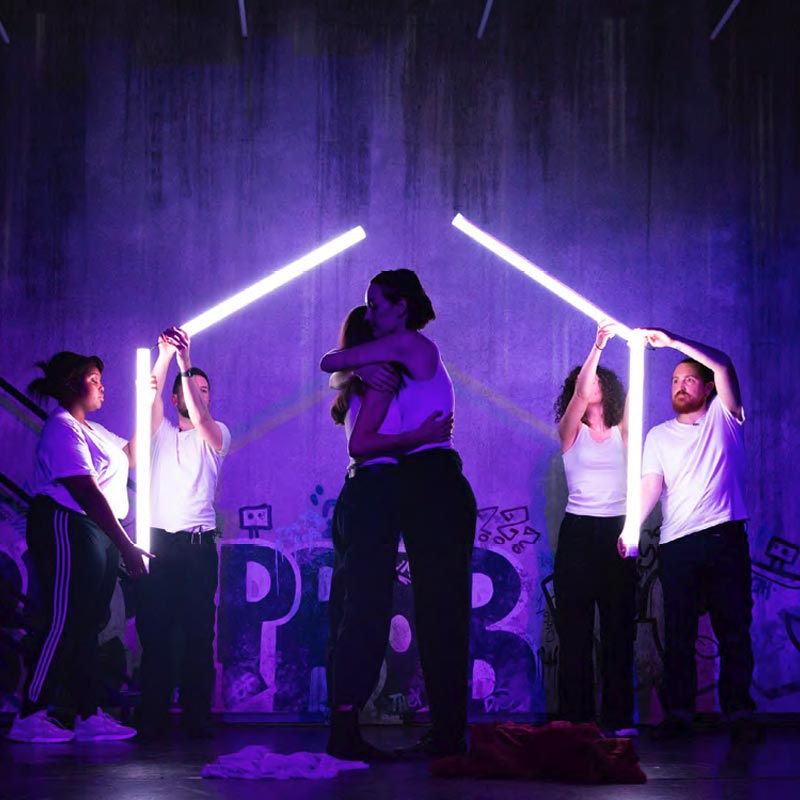
Beyond Carbon – Key Insights
Arts Council England’s Environmental Responsibility Investment Principle challenges organisations to take active responsibility for the environment in every aspect of their work.
This goes beyond merely collecting data and reducing CO2e emissions; it’s about integrating environmental considerations into every facet of practice.
Practical examples from the Beyond Carbon Survey demonstrate the three core elements underpinning the Environmental Responsibility Investment Principle.

Use the dropdown links to explore the key insights in more detail with examples of how 47 cultural organisations are reducing waste by recycling costumes, measuring and reducing their carbon footprint, establishing biodiversity benefits in programming, changing policies and governance structures and presenting work on climate justice and environmental awareness.
Understanding the data
-
Many organisations demonstrated strong examples of building roadmaps, targets and establishing baselines for long-term improvement. The Museum of London undertook a detailed consultation to measure and establish a baseline assessment of their footprint. By separating their environmental reporting into two footprints, SPILL Festival reported that they were able to use their data to better track their progress and identify areas for improvement.

Plan, action and change
-
This year’s reporting highlights waste as a major impact area, with organisations implementing various strategies to address it. Open Sky Theatre focused on reusing, recycling, and borrowing materials, while New Adventures’ Environmental Manager ensured 100% of costumes were recycled or reused. IOU Theatre has cut costs and emissions by repurposing materials, Lyrici Arts minimised transport emissions with compact sets, and Charnwood Arts upcycled surplus materials, often sourcing second-hand items from charity shops.
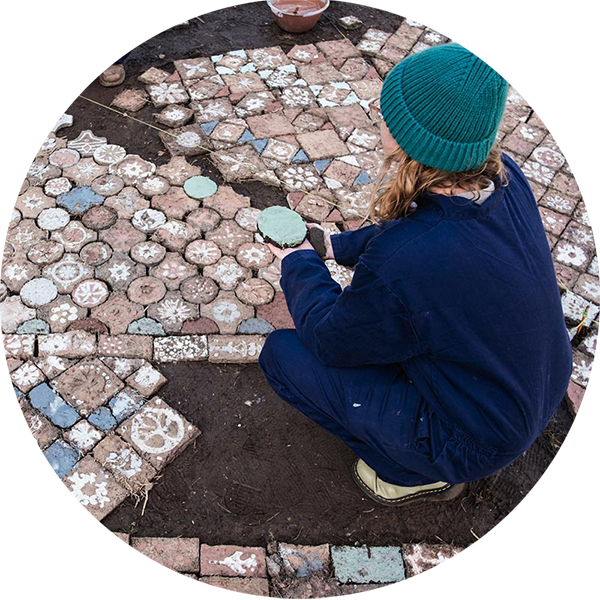
-
The new portfolio includes organisations at various stages of their environmental journey –some making crucial changes like switching to LEDs, while others are upgrading their Building Management Systems (BMS) and advancing their carbon reduction efforts. Battersea Arts Centre (BAC) has a 5-year plan which includes zoning the building to optimise activities and implementing a funded BMS to reduce energy use and track carbon data. This will enable BAC to improve efficiency, cost savings and a more comfortable experience for audiences.
Many organisations struggle with data collection in shared spaces due to accessibility and transparency issues. However, Creative Arts East improved their environmental goals and staff wellbeing by securing space in another cultural building. Reporting highlighted numerous examples of organisations transitioning to renewables, either by installing new technology or switching tariffs. While there were reports of some organisations not yet able to address energy issues due to lack of resources, others had been successful in funding bids enabling significant progress. These transitions not only reduced their carbon footprints but also demonstrated the benefits of sustainable energy practices, including organisations such as Disability Arts Online who focused on minimising their digital footprint when redeveloping their website.
 Market Hall immersive dome. Image courtesy Real Ideas Organisation CIC. Photo © Jay Stone.
Market Hall immersive dome. Image courtesy Real Ideas Organisation CIC. Photo © Jay Stone. -
Transport is a key contributor to an organisation’s carbon footprint, so implementing schemes to monitor and improve staff travel impacts is an effective way to reduce emissions. New Earth Theatre has reduced travel impacts by employing staff to work remotely, minimising travel between London and Manchester. The Children’s Bookshow operates with a small team, working remotely without an office, and relies on public transport and existing venue resources. They limit long-haul flights and have shifted to online meetings, significantly reducing their carbon footprint. The National Centre for Writing lobbied for a local bike station, participate in the Bike to Work Scheme, encourage public transport for artists, and promote car-sharing among staff when possible.
Audience travel and touring are among the largest contributors to emissions within the creative and cultural sector, and organisations are actively working on various strategies to address and reduce this impact.
By acknowledging and addressing touring travel impacts, including considerations around sets and costume freight, Open Clasp Theatre Company minimised travel by performing at a single venue and rehearsed within the same city, with 45% of the team based locally in Newcastle upon Tyne. Outlands Network similarly kept their touring footprint low by having artists travel together with portable equipment, avoiding the need for vans.
Many organisations face the challenge of working internationally. Greenwich+Docklands Festival reduced carbon emissions by encouraging train travel for international artists where possible, despite higher costs. During their 2023-24 tour, New Earth Theatre focused on reducing their footprint by choosing hotels with environmental credits, selecting flights with fewer emissions than average and using the Theatre Green Book to guide their efforts.

-
Suffolk Libraries is launching nature-inspired programmes, Wild Reads and Go Wild, for Autumn Winter 2024. They’ve recruited two Environmentalist in Residence roles to promote environmental awareness through their creative activities. Midlands Arts Centre (MAC) has featured programming like the Art, Nature and Wellbeing season, including Michael Pinsky’s Pollution Pods and the Big Green Weekender. London Arts and Health moved to St. Margaret’s House, benefiting from its environmental focus, and organised a series of events exploring climate, health and creative practice. Highlights included panels with experts like Chantelle Lindsay from London Wildlife Trust and Kwesia, known as City Girl in Nature, who shared her transformative experiences with nature. Watch here.
Several organisations reported on using site space to promote biodiversity. Talking Birds Theatre Company created planters and a wildflower meadow, while Hastings Museum and Art Gallery improved their landscape by delaying mowing and launching engagement activities, aligning with local environmental policies. Wysing Arts Centre appointed a Site and Environmental Futures Manager to lead their transition to renewable energy, manage biodiversity initiatives, and reduce environmental impact, with ongoing biodiversity monitoring and development, rainwater harvesting, and the prohibition of herbicides and pesticides on their 11-acre site.
 Pocket Park. Credit Rebecca Chesney
Pocket Park. Credit Rebecca Chesney
Influence, educate and advocate
-
Metal Culture’s Shift network, a collective of 60 Liverpool arts organisations, recently hosted an event at the Everyman Theatre, sponsored by Ecotricity. The event, which focused on the Arts Green Book and potential energy cost reductions, fostered increased engagement and membership while promoting collaboration with Northern networks like Sustainable Arts in Leeds and Greater Manchester Arts Sustainability Team, and Project Constellation. Similarly, Future Arts Centre facilitated a practical discussion on green agendas and the Theatre Green Book, involving over 40 arts centres in a knowledge-sharing exchange that encouraged new sustainability initiatives and strengthened sector connections.
DanceSyndrome is leveraging its community outreach to raise environmental awareness, engaging both staff and participants in sustainability practices through dance, while collaborating with venues to enhance joint environmental responsibility. Northern Broadsides’ Iron People project engaged over 500 participants in creativity days inspired by Ted Hughes’ books, focusing on recycling, pollution, and nature, and gathering feedback on local environmental concerns. Somerset Art Works are integrating environmental practices into artists’ work, encouraging artists to share their sustainability strategies and incorporate them into projects. At the John Hansard Gallery, the JHG Sustainability Group has led a waste audit, hosted presentations, and organised Green Awareness Month, Green Away Day, and a solar farm visit for staff, advancing internal sustainability initiatives.
 Crying Out Loud – Grasshoppers by Circus Katoen at Circomedia, 2023. Photo credit Michiel Devijverr
Crying Out Loud – Grasshoppers by Circus Katoen at Circomedia, 2023. Photo credit Michiel Devijverr -
A prime example of climate-themed programming is Oxford Contemporary Music (OCM)’s cocommissioning Warning Notes, an outdoor immersive show by Mark Anderson, utilising repurposed materials to address social and ecological issues. Funded by Without Walls for a 2024 tour, the production exemplifies sustainable practices. OCM also collaborated with Tŷ Cerdd Music Centre Wales, supporting four artists in developing environmental and climate-themed projects through mentoring and financial aid.
Liverpool Arab Arts Festival presented works on climate justice by artists Arwa Aburawa and Turab Shah, and the multidisciplinary performance What the Dog Said to the Harvest. Lancaster Arts focused on integrating social and environmental justice into its vision, driven by artistic practice. This involved staff and board training, a creative event with artists and environmentalists, and a public statement on environmental justice. Key outcomes included incorporating environmental justice into upcoming commissions, and contributing to the launch of Lancashire Arts Network for Developing Sustainability (LANDS).
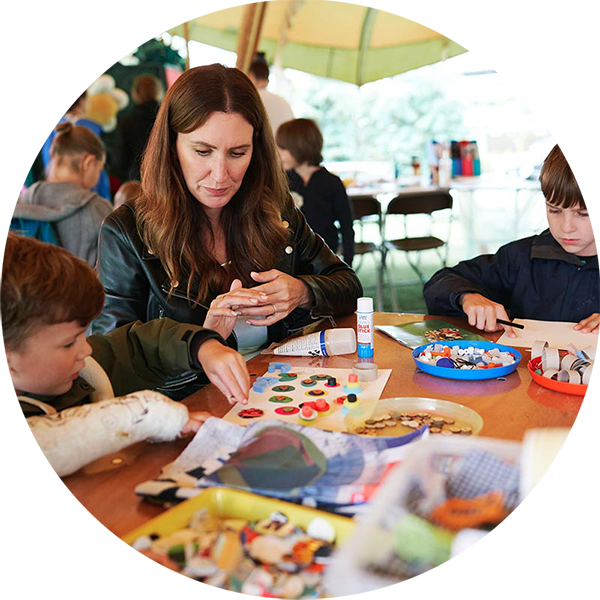
-
The Poetry Translation Centre has implemented a Green Rider to promote sustainability, introduced six pro-rata days per year for employees to engage in climate action, and explored green team-building experiences. They also focus on opting for digital solutions over physical ones, such as using QR codes instead of printed programmes and preferring online meetings over in-person ones. Clod Ensemble has advanced internal sustainability by providing carbon literacy training for all staff, adopting ‘digital first’ marketing strategies, and advocating for better waste management with their landlords. Their sustainability policy is now part of staff induction, and they have committed to the Culture Declares Emergency pledge. Humanhood Dance Company has overhauled their environmental policies by implementing a comprehensive Environmental Policy, Action Plan, and Green Rider, focusing on the 5Rs: Refuse, Reduce, Reuse, Repurpose, and Recycle. Their new policy integrates sustainability into all operations, including zero-plastic policies for workshops and eco-friendly travel practices.
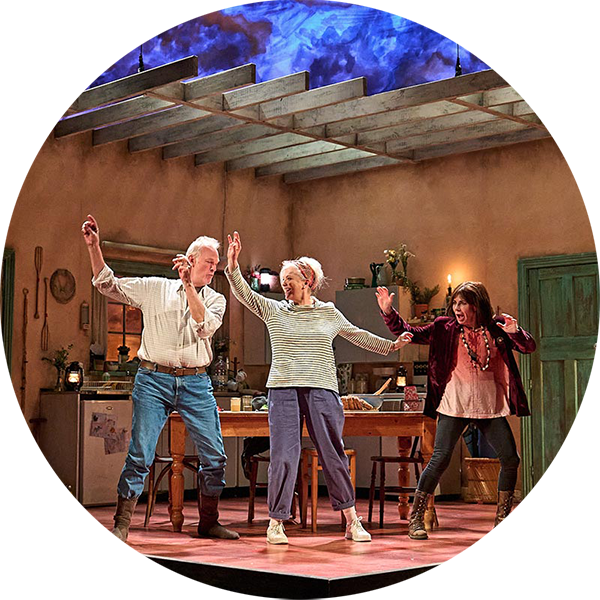 The Children – Manuel Harlan
The Children – Manuel Harlan -
Milap Festival Trust recently relocated to a new office in Liverpool where they are collaborating with their landlord to enhance environmental policies. This includes new recycling initiatives and reducing single-use plastics. Their new office setup, which includes meeting rooms for board and staff meetings, also helps minimise travel and its associated impacts.
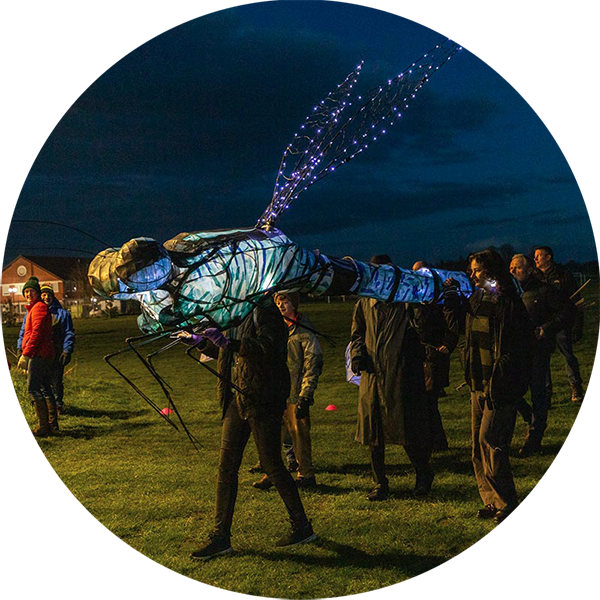
-
Actors Touring Company has appointed a Climate Board Champion who has engaged with the Board Environmental Champions Programme and presented their touring practices at climate conferences, including at the National Theatre. Similarly, North Music Trust introduced an Environment and Equality, Diversity and Inclusion (EDI) Lead role to integrate sustainability into all departments, advancing their environmental goals and raising internal awareness. Open Eye Gallery formed an Environmental Working Group, added board members with environmental expertise, and collaborated with Liverpool’s SHIFT network and the Arts Green Book to achieve sustainability targets. Kiln Theatre trained seven Green Team members in carbon literacy this year, with plans to train all staff next year, and their Artistic Directors attended the Making Theatre in a Time of Climate Crisis conference, leading to the production of their first Green Book show in 2024-25.

Stories of Action
Capital investment for reducing energy use
To reduce their environmental impact, Creative Folkestone focused on finding ways to reduce energy consumption at their performing arts venue, Quarterhouse. In the face of rising electricity bills they needed to bring costs down and finding more efficient and environmentally friendly ways of generating power became a priority.
By procuring grant funding Creative Folkestone were able to install 87 solar panels on their venue, reducing electricity costs by 40% in the first month. The panels have produced over 32,000kWh of clean energy in a year, saving around £17,000. They have estimated that these energy savings are equivalent to driving a car around the world six times and the investment will have been paid off in just one and a half years.
Quarterhouse (Solar Panels) – Creative Folkestone. Credits Matt Rowe
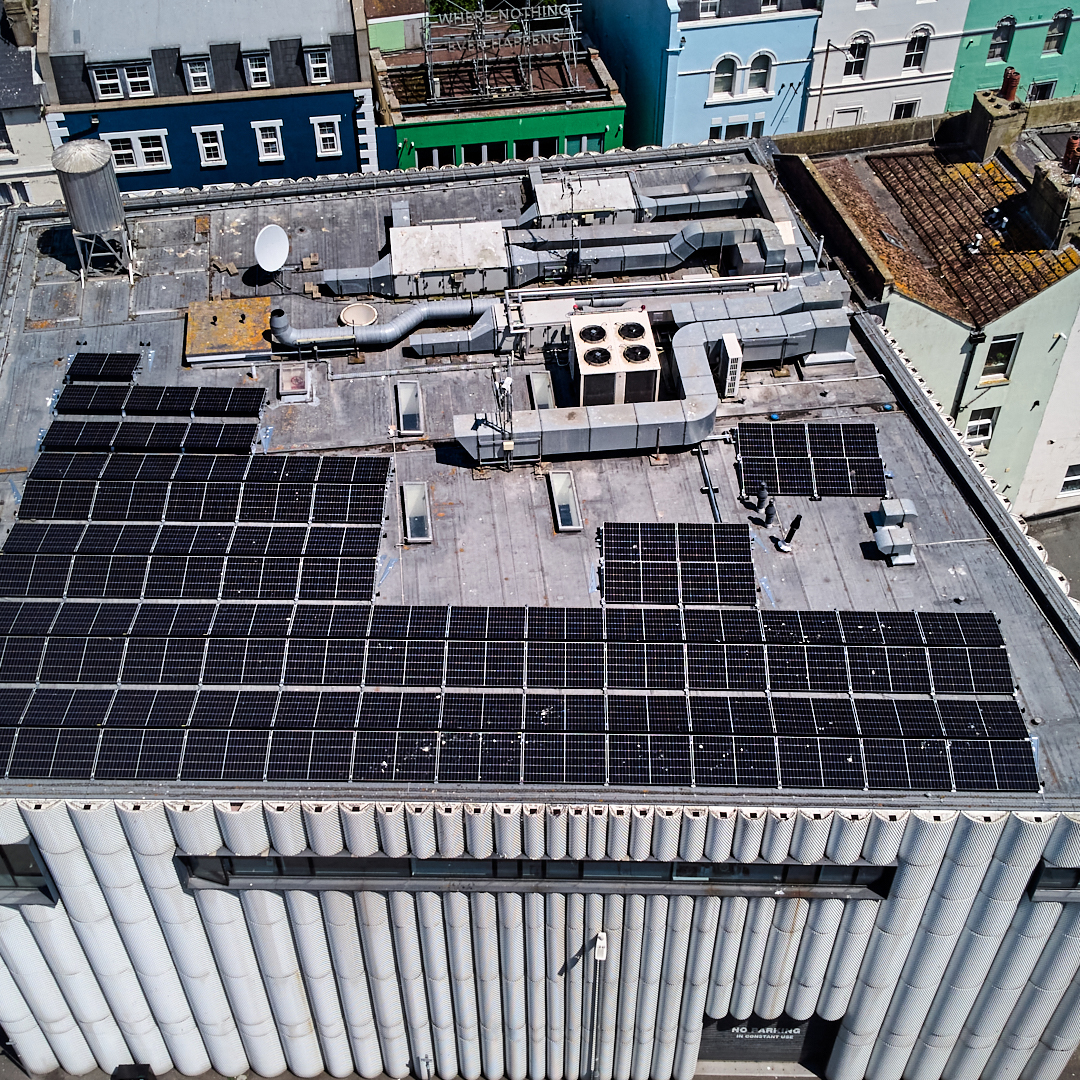
Creative community skills building for sustainability
Global Grooves is working on incorporating a small hydro turbine into its venue, The Vale, and engaging audiences with this project through programming, training, and direct participation. They aim to reduce the organisation’s environmental footprint whilst paying homage to the industrial past of their venue, involving the community and reflecting the project through art.
They encouraged the community to take a central role in designing and co-creating the turbine. Global Grooves are not only invested in skills development for the participants but they also encourage the participants to bring their own knowledge, and to lead events around the project from nature walks to workshops on bike generators.
They codevised a digital skills week to engage young people that led to the group coding their own website for the neighbouring large scale hydro power station where people can learn about the station and check its hydro generation in real time. They included an artist commission as part of The Vale hydro project, with the aim to engage different audiences as well as explore the intersection between art, sustainability and nature.
Water Play – Global Grooves. Credit Sam Orchard
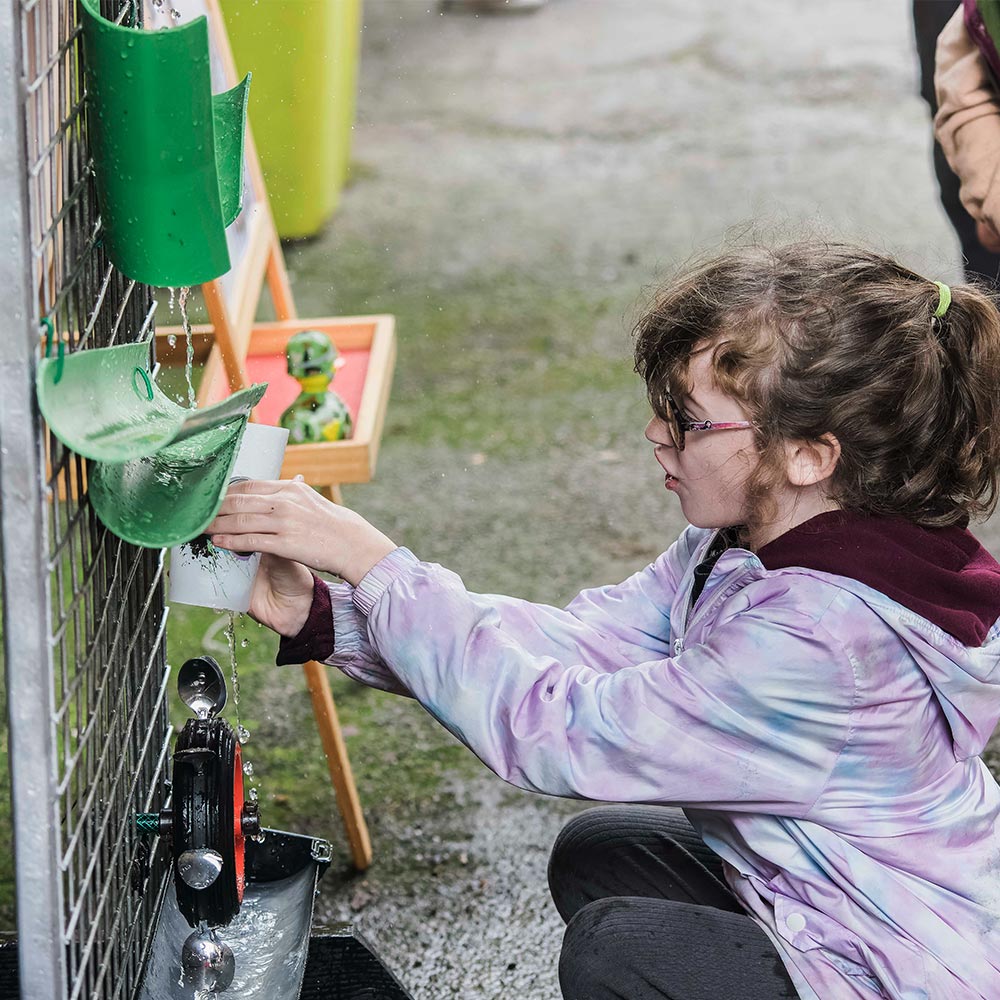
Sustainable approaches in temporary spaces
Jelly is a nomadic organisation with years of experience of making use of odd and empty spaces with few options when it comes to sustainability. Despite having limited control, they have found ways to manage their current space through switching to 100% green energy, opting for a smart meter and using low impact infrared heaters.
To make the space more welcoming, they created self-built artist studio pods which can be readily disassembled and reconstructed, with the help of U-Build. Their resourcefulness is also reflected in their approach to supplying water to the space. The empty shopping unit had no running water and instead of opting for adding plumbing, they decided to buy a mobile sink that could travel with them to future venues.
Jelly chose for the sink to have clear water carriers to help the artists visualise and reduce the water consumption. Alongside their day-to-day work, Jelly has set up a sustainability forum for arts and heritage organisations in the area to share knowledge, support each other and develop ideas.
Open for Art – Jelly. Credit John Angerson
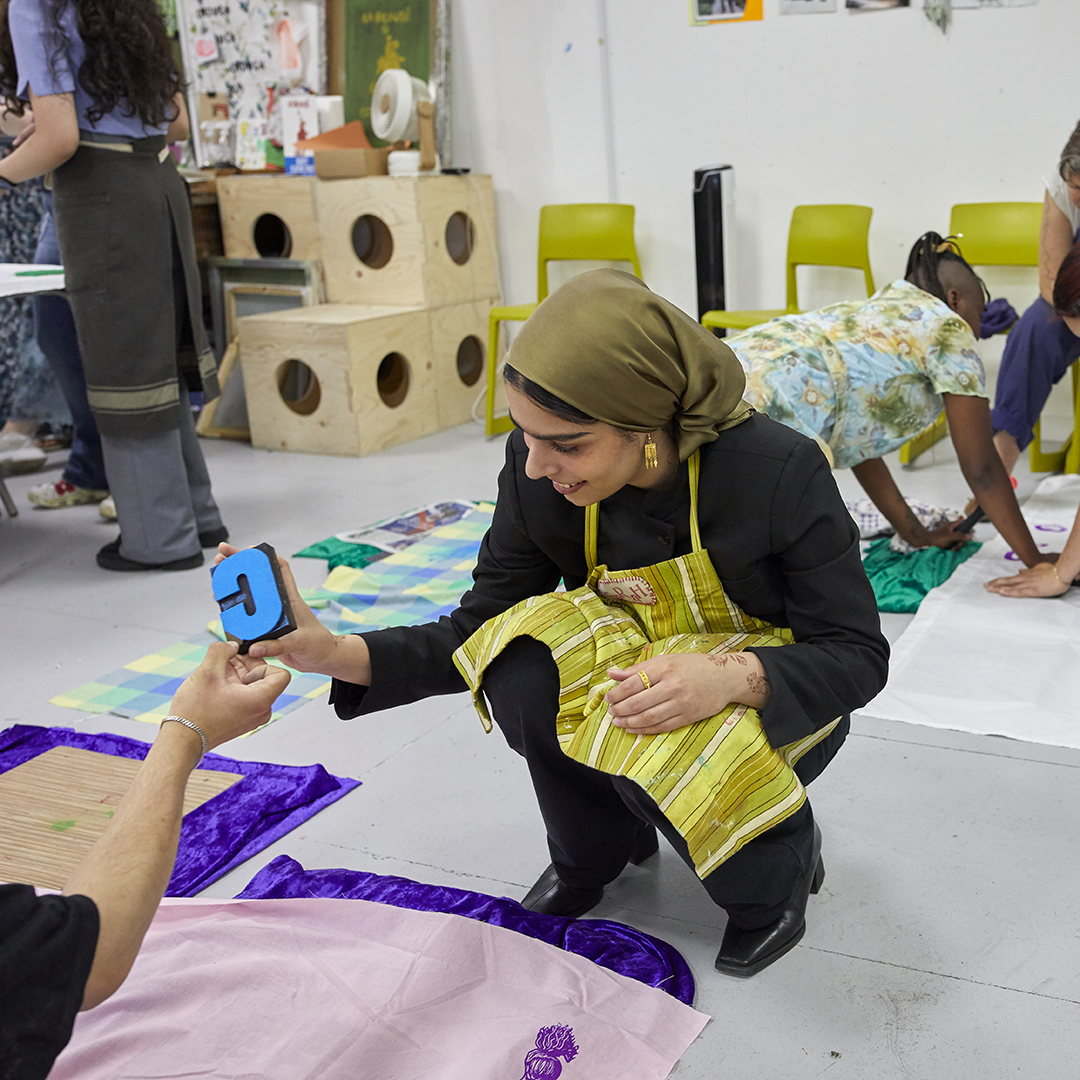
Creatively engaging audiences with creating a healthy world
In collaboration with artist Henry Driver, LEVEL Centre commissioned Water Portals – an interactive digital journey exploring the microscopic world of water and raising awareness about the pollution in our waterways.
They invited audiences to discover the beautiful microbes that live in our rivers, lakes and seas, and to understand the crucial roles the audience could play in creating a healthy world.
This piece also included community participation encouraging audience members to take a pledge on actions they could take to protect our waters. The installation provided an opportunity to highlight how these important microbes are at risk from climate change, and what simple things we can do to make a difference.
Water Portals – Level Centre Ltd. Credits Henry Driver, David John King Photography
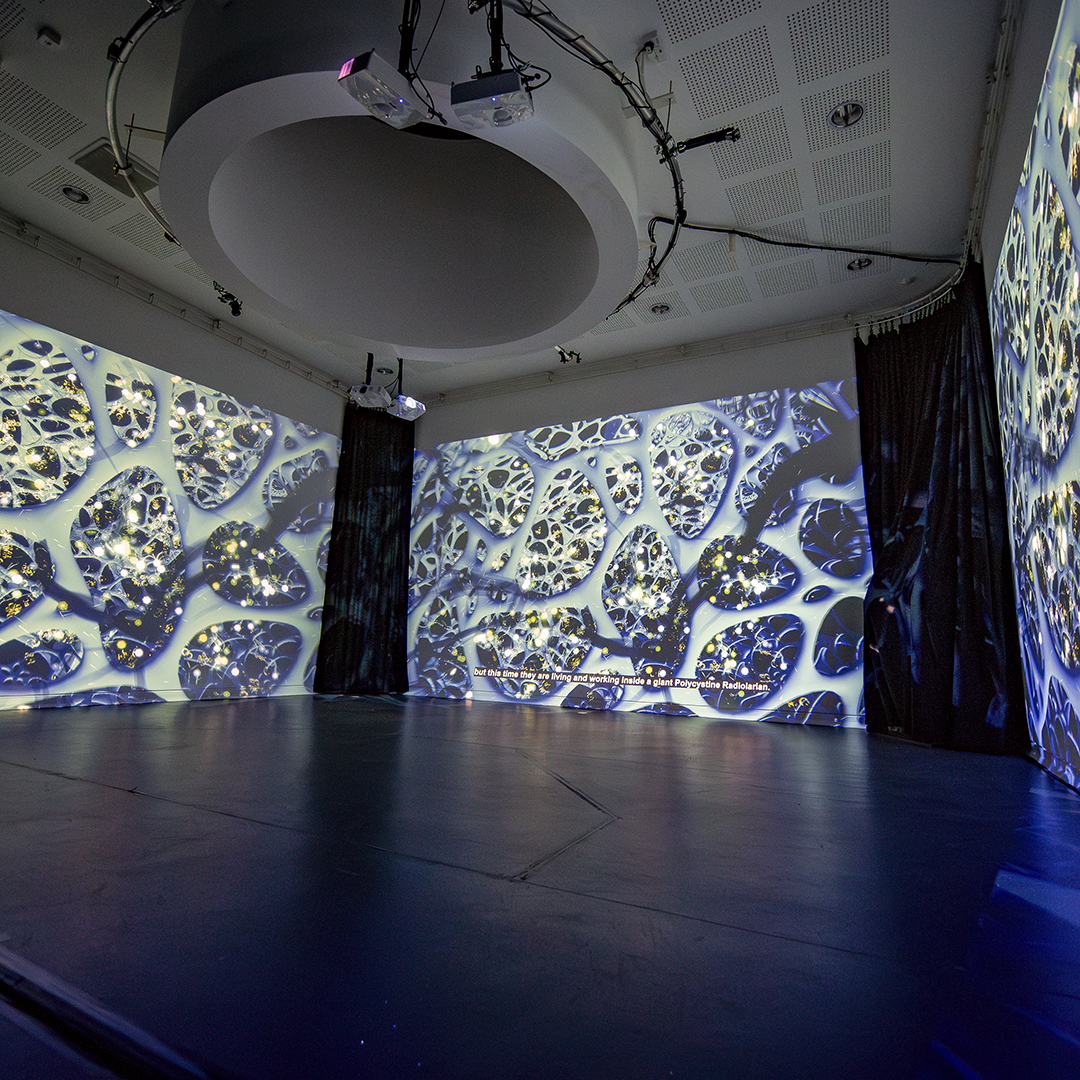
Collaborating with nature in an urban setting
Over the last three years, Multistory has been delivering Green Roots, an urban greening arts and cultural programme of artist and community-led activities across three of Sandwell’s towns. The programme responds to the needs and challenges of each town as identified by local communities, aligns to Sandwell Council’s Urban Greening scheme and encourages dialogue and skills development on topics of nature and biodiversity.
As part of the programme, Multistory has delivered projects including a community-grown wildflower meadow and a nature conservation training and skills development programme in the use of tools with Sandwell College SEN students. For another one of the projects, Multistory partnered with Bostin’ Arts and local independent shops in Wednesbury to create bespoke planters filled with a variety of plants outside each shop, enhancing the high street with greenery.
Community groups attended drawing, growing and mindfulness workshops and made woven obelisks for the climbing plants in the planters. Multistory also delivered workshops themed around greening, nature and memory, with activities like observational drawing of plants and seeds, creating natural dyes from vegetables, printing and smallscale planting. The project not only enhances the visual appeal of the town but has also fostered a sense of community, environmental consciousness and empowerment to voice concerns among residents and businesses, paving the way for future collaborative projects aimed at transforming Wednesbury into a more vibrant and sustainable town.
Participants from the Centre for Oneness group at the observational drawing workshop led by Bostin’ Arts in Wednesbury, May/June 2024, Multistory © Multistory
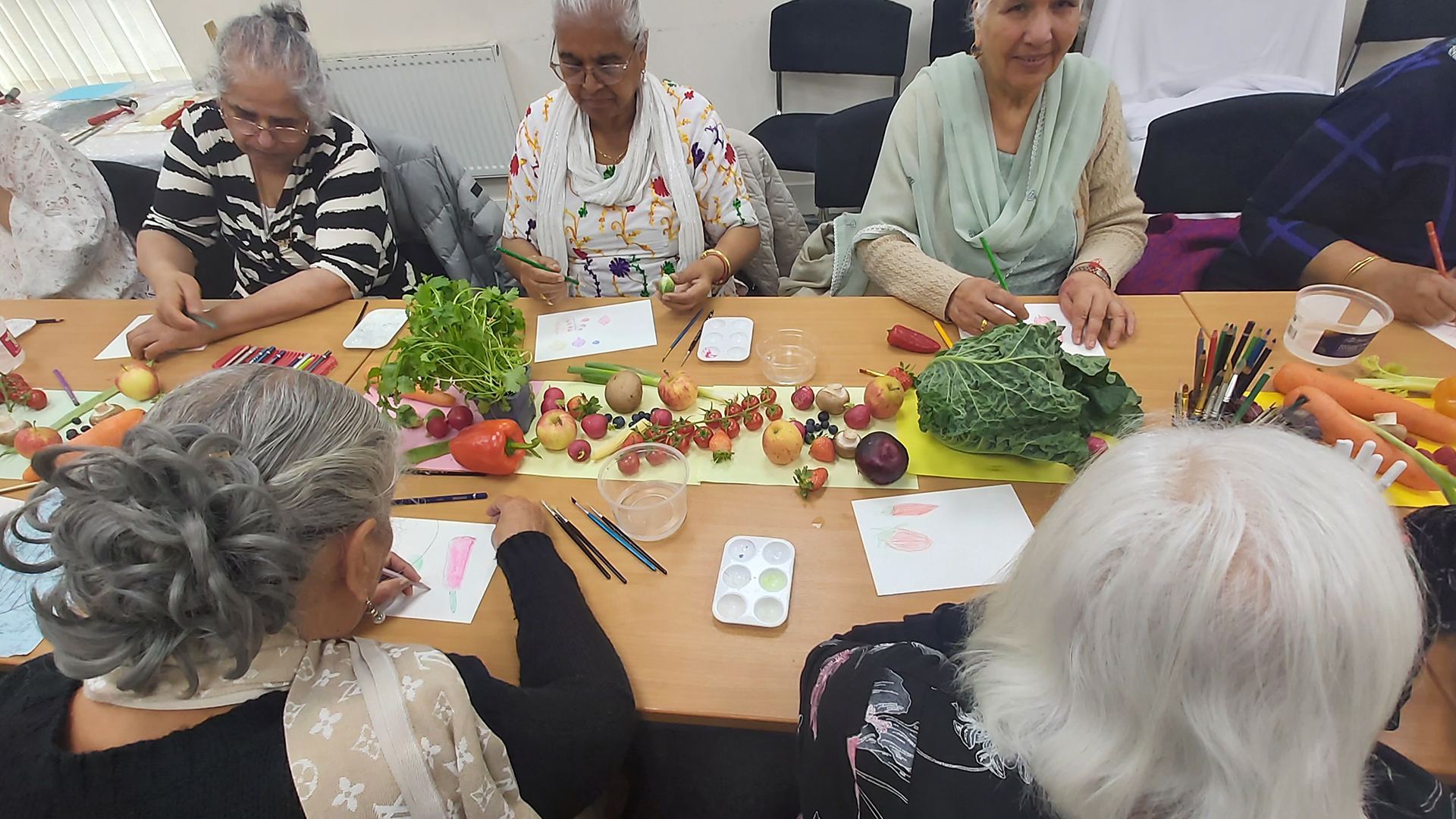
Sustainable touring and partnerships
Oily Cart’s international collaboration with Australian theatre company Polyglot explored working on sister productions of When The World Turns. This involved creating the show first in Australia and then remaking it in the UK with a new cast, based on the Australian blueprint of the show, with 50/50 creative input from both organisations.
Sustainability was at the centre of their planning with the focus being on limiting personnel travel to the minimum required and consideration for design by working with leading eco-scenographers in both Australia and the UK. With the set containing approximately 400 living plants, Oily Cart established and communicated a Manifesto of Care to set out their plans for ensuring that all living beings in their show are cared for.
Each version of the show used distinct materials and plants to reflect the local environment and needs of the audience. This show both prioritised sustainable touring practices as well as helped foster a deeper understanding and connection with the planet through its message and sensory experiences.
When The World Turns – Oily Cart. Credits Theresa Harrison

Addressing procurement and influencing others
The Royal Ballet and Opera (RBO) have identified their suppliers and contractors as their main source of emissions, accounting for around 80% of their total emissions. In preparation for setting Scope 3 emissions targets, RBO conducted a spend analysis to estimate emissions based on their purchases and started to survey the suppliers that they spend the most money with, gathering data on environmental policies, accreditations, targets, energy sources, transportation and training.
The results showed that a large number of companies that had not started to look at any of these areas or did not consider this a priority. To address this, RBO set up a workshop for their suppliers aimed at promoting collaboration, sharing of best practices and common challenges and understanding how RBO can help them become more sustainable.
As a result of the workshops, RBO has developed a standard set of questions for suppliers to address sustainability issues. Additionally, the workshop has established networks among suppliers, with many committing to calculate their carbon footprints annually. Internally, RBO has already started to implement some of the recommendations made by the suppliers and plan to hold these workshops twice yearly to foster an ongoing dialogue.
Photo: Ardian Lumi
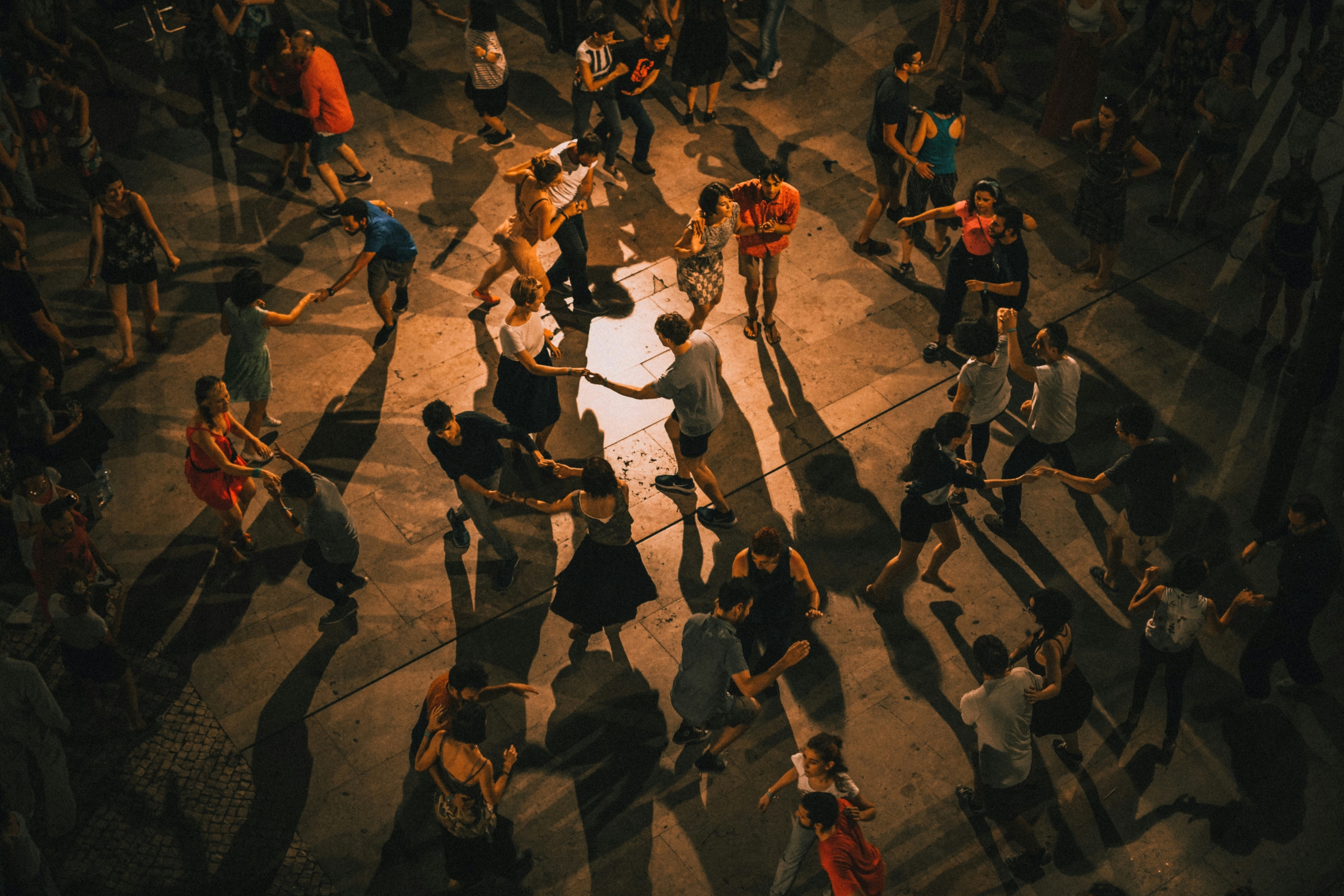
Adapting to future climate changes with nature
For the Shakespeare Birthplace Trust (SBT), adaptability and resilience has been required on multiple fronts as it works to both conserve the centuries-old properties whilst also making them accessible for the public to explore.
In 2022, record temperatures across the UK had a catastrophic effect on the existing planting in the Golden Garden, with many of the plants unable to recover. This sparked the Gardens’ team to research what plants could be more resilient to extreme temperature fluctuations and prolonged periods of wet weather.
Their research took them horticulturally to the Mediterranean, looking at bronze fennel and Turkish sage, alongside those that would have been familiar to the Shakespeare family and mentioned in his work, including rosemary and an olive tree. SBT addressed challenges such as free-draining soil to avoid excessive moisture and drip irrigation during drought. Despite dry periods, the irrigation system was only used four times in 2024, showcasing sustainable practices in action.
New Place Garden – Shakespeare Birthplace Trust. Credit Sam Allard, Shakespeare Birthplace Trust

Creative programming for young people
An area of focus for The Poetry Society is engaging young people in poetry to increase understanding around biodiversity loss and climate breakdown. Across 2023-24, their online community for young writers, the Young Poets Network, ran three environmentally themed writing challenges, in which 634 young people aged 7-25 wrote 1,183 new poems on subjects including perceptions of animal cuteness, and finding peace and improved mental health through nature.
There were opportunities for young poets to perform their work live, and some of the most inspiring poems were published online and in print by The Poetry Society, where they reached a range of audiences, from global communities to thought leaders. The Poetry Society also works in formal education and skill development, where they have created resources mapped against the curriculum designed to encourage pupils to use poetry as a tool to explore biodiversity.
Each resource features a recent poem about nature, written by a young poet from their youth programmes. By putting writing by young people at the forefront of projects for young people, they aim to demonstrate to school-age audiences that the issues explored in the poems are relevant to the pupils’ own lives and their voices are valued.
Creating poems with poets Jonah Corren and Poppy Jayne Jones, Poetry Society bog poetry workshop, Plymouth, 2024 – The Poetry Society. Credit Laura Ludtke for The Poetry Society
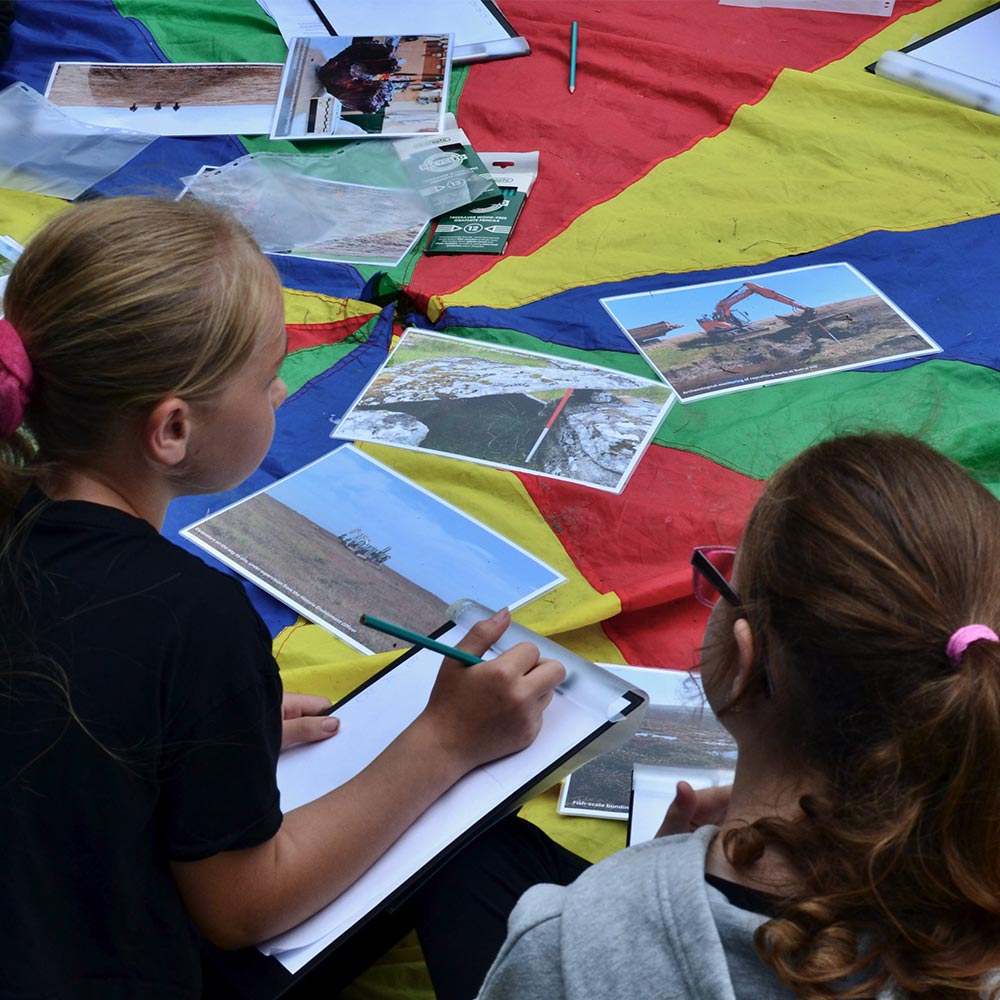
Community access equipment library for resource sharing
As part of Croydon’s year as London Borough of Culture, Zoo Co Creative established a library of access equipment that could be loaned out free of charge to make events more accessible without having to purchase whole sets of new equipment.
The Access Library was a great success, with sets of items being loaned out 35 times, benefiting a large number of event attendees as well as providing a unifying moment between disability rights and the climate emergency. Partnerships with Croydon cultural organisations were strengthened through this project, and Zoo Co Creative provided free consultancy services to further accessibility initiatives.
The Access Library also led to further sustainable practices within Zoo Co Creative by using the storage space to process their items more sustainably and sharing unused production items with the community.
Perfect Show For Rachel Improbable 8 – Zoo Co Creative. Credit Ikin Yum
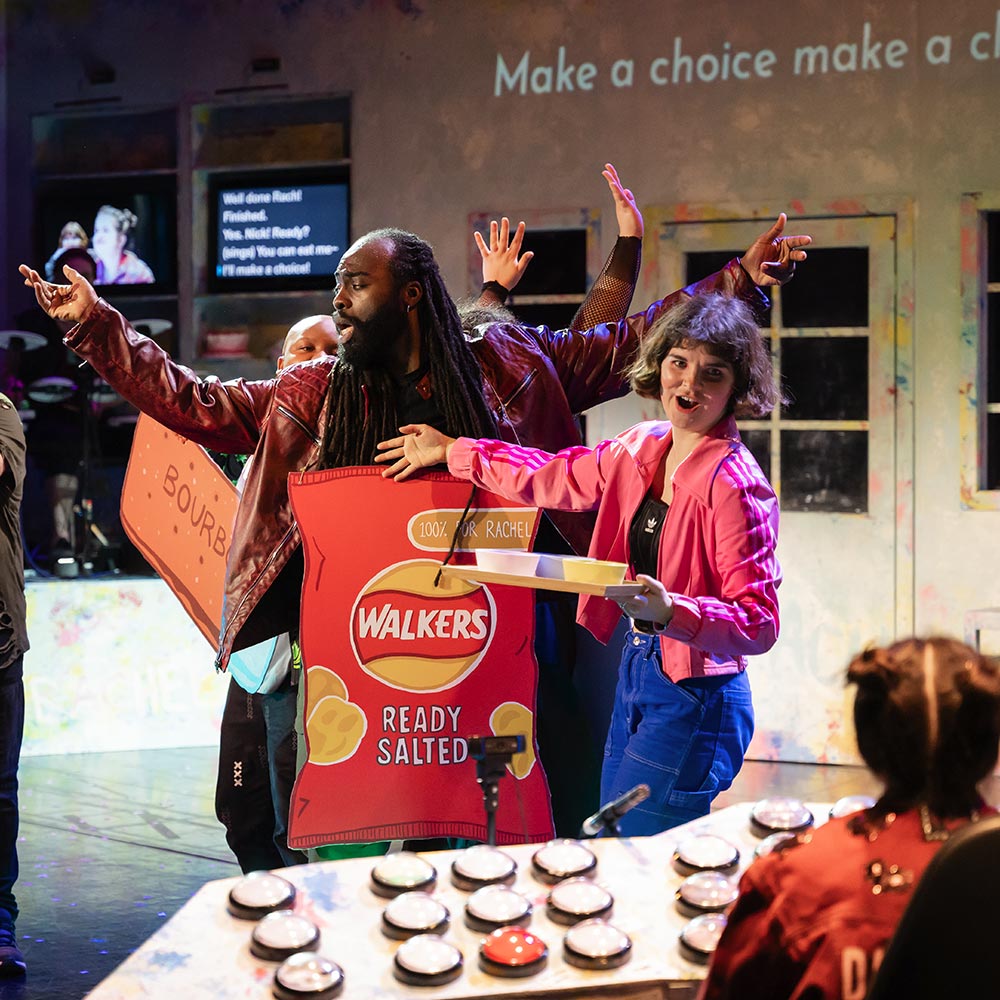
Appendices
-
Results normalisation
The energy usage results were normalised using the average UK household electricity and gas usage17:
- Electricity = 2,700 kWh
- Gas = 11,500 kWh
- Total = 14,200 kWh
Cost analysis
For the cost analysis, costs were based on an approximate unit price of:
- 0.07 £/kWh for gas2
- 0.29 £/kWh for electricity18
- 0.08 £/kWh for district heating19
Custom emissions
The current database structure does not provide information on whether an emissions value is custom or not. The make up for this, the following rule was applied:
- When “consumption” = 0 AND “emissions kg co2e” =/ NIL, then “custom emissions (y/n)” = y
17 SOfgem (source here).
18 Calculated averages for 2023 Q2-3-4 and 2024 Q1 of gas and electricity prices in the non-domestic sector, including CCL, not including standing charge (source here).
19 Heat Trust district heating average price (source here).
-
Creative Climate Tools updates to Waste and Materials
In 2023, Julie’s Bicycle consulted with the sector and implemented a variety of updates to the Creative Climate Tools. These included improved business travel and touring functionality, carbon budget setting, net zero carbon pathways, return on investment modelling, forecasting, custom emissions and bespoke project footprints. Waste and material emission factors were also closely analysed using the expertise of external consultants. It was agreed that in order to create as full a picture of waste and materials use across the sector as possible, that upstream and downstream emissions should be included. Therefore, when organisations submit data into the waste or materials footprints on the tools, the generation of that material is included as well as the treatment of it after use, i.e. recycled, incinerated, landfill etc, and avoided burden20. As a result, the new method of recording CO2e for waste and materials has produced significantly higher emissions than in previous programmes. However, this is part of the goal/aim to improve calculations to offer a more comprehensive picture of the sector’s consumption.
20 See pages 3 and 4 for definition of Avoided Burdens (source here).
-
Voice from the Movement – Justine Themen
Most recent positions:
Leadership Associate, Royal Shakespeare Company;
Co-Artistic Director 2021, Belgrade Theatre
Current & recent work:
Like There’s no Tomorrow, commissioned by NT Connections/selected for Connections India ‘24
https://www.ncpamumbai.com/event/like-theres-no-tomorrow/
Nothello by Mojisola Adebayo, Belgrade Theatre/ City of Culture 2021
https://www.belgrade.co.uk/events/nothello/
Coventry Moves, the opening event for Coventry UK City of Culture 2021
https://www.bbc.com/news/live/uk-england-coventry-warwickshire-57363936
This Little Relic by Karla Marie Sweet, BBC Radio 3, Contains Strong Language
-
Organisation Location Artform Topic Creative Folkestone South East Visual Arts Capital Investment for reducing energy use Global Grooves North Combined Arts Creative community skills building for sustainability Jelly South East Visual Arts Sustainable approaches in temporary spaces LEVEL Centre Ltd Midlands Combined Arts Creatively engaging audiences with creating a healthy world Multistory Midlands Combined Arts Collaborating with nature in an urban setting Oily Cart London Theatre Sustainable touring and partnerships Royal Ballet & Opera London Combined Arts Addressing procurement and influencing others Shakespeare Birthplace Trust Midlands Museums Adapting to future climate changes with nature The Poetry Society London Literature Creative programming for young people Zoo Co Creative Ltd London Theatre Community access equipment library for resource sharing -
Transforming Energy – Capital Investment Cohort 1
Organisations
- Courtyard Farnham Maltings
- London Transport Museum
- Midlands Arts Centre, Birmingham
- Queen’s Theatre
- Royal Opera House
- Royal Shakespeare Company
- Sage Gateshead
- Sadlers Wells
- Unicorn Theatre
- Watershed
-
Resources and further reading
Julie’s Bicycle recent resources developed under Arts Council England’s Environmental Programme
- Briefing: Counting on Culture: How to stop financing the environmental crises
- Blog: How can cultural organisations adapt to climate change?
- Programme: ACE Environmental Programme 2023-26
- Webinar: An introduction to climate adaptation
- Report – Energy Impacts: Taking meaningful action in the midst of a crisis
- Guidelines – Environmental Policy and Action plans: An overview
- The Creative Climate Justice Resource Hub
- Creative climate justice guide
- Briefing – Food culture: The impacts of what we consume
- Taking the Temperature series
- Culture: The Missing Link – an online event at COP26
- Briefing report: Putting a price on Carbon
- Putting a price on carbon: webinar
- Briefing Report: Environmental Sustainability in the Digital Age of Culture
- Webinar: Sustainable digital creativity
- Webinar: Sustainable cultural mobility
- Webinar series: Creative Climate Literacy 101
- Creative Climate Chats
Other Julie’s Bicycle resources
- Top Tips Guides for Museums and Music sector
- The recently launched free Creative Climate Tools badge celebrates organisations taking environmental action.
Other resources
- Arts Council England Strategy 2020-2030 Let’s Create
Arts Council England
Arts Council England (ACE) is the national development agency for creativity and culture.
We have set out our strategic vision in our strategy, Let’s Create, that by 2030 we want England to be a country in which the creativity of each of us is valued, and where every one of us has access to a remarkable range of high-quality cultural experiences.
Arts Council England
The Hive
49 Lever Street
Manchester
M1 1FN
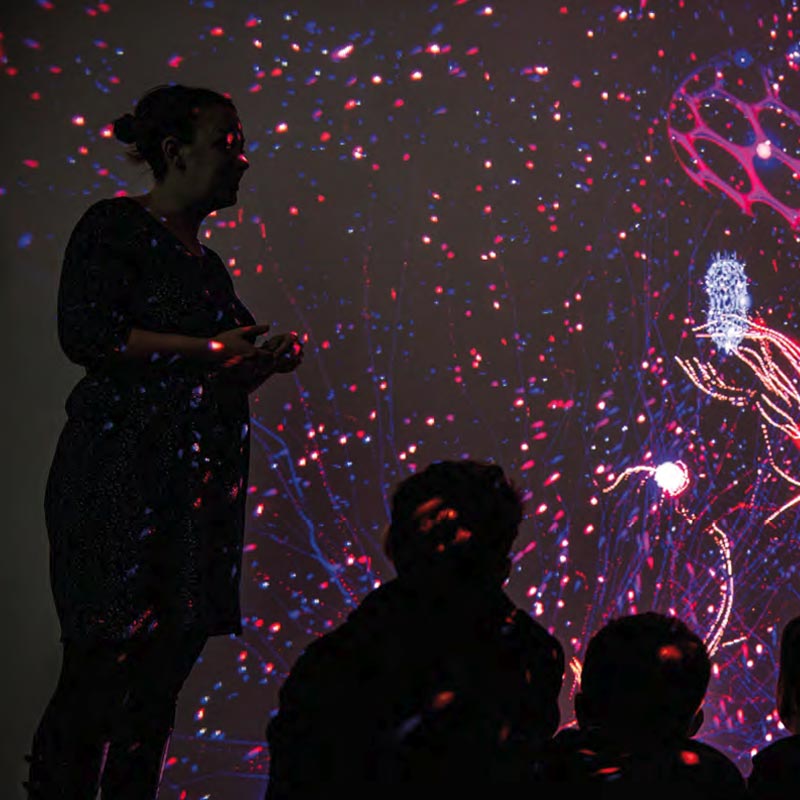
Email: enquiries@artscouncil.org.uk
Phone: 0161 934 4317
LinkedIn: @ArtsCouncilEngland
X: @ace_national
Instagram, Threads: @aceagrams
Facebook: @artscouncilofengland
Charity registration number: 1036733
Julie’s Bicycle
Founded in 2007 to respond to the climate crisis, Julie’s Bicycle is working globally across the creative sector to reduce greenhouse gas emissions and catalyse the green creative economy.
Working with over 2,000 organisations, NGOs and governments worldwide, Julie’s Bicycle has developed an approach which harnesses the power of the creative sector to communicate the reality of the climate crisis, advocate for science-based solutions, take bold practical action, and offer support and advice to those who share their vision.
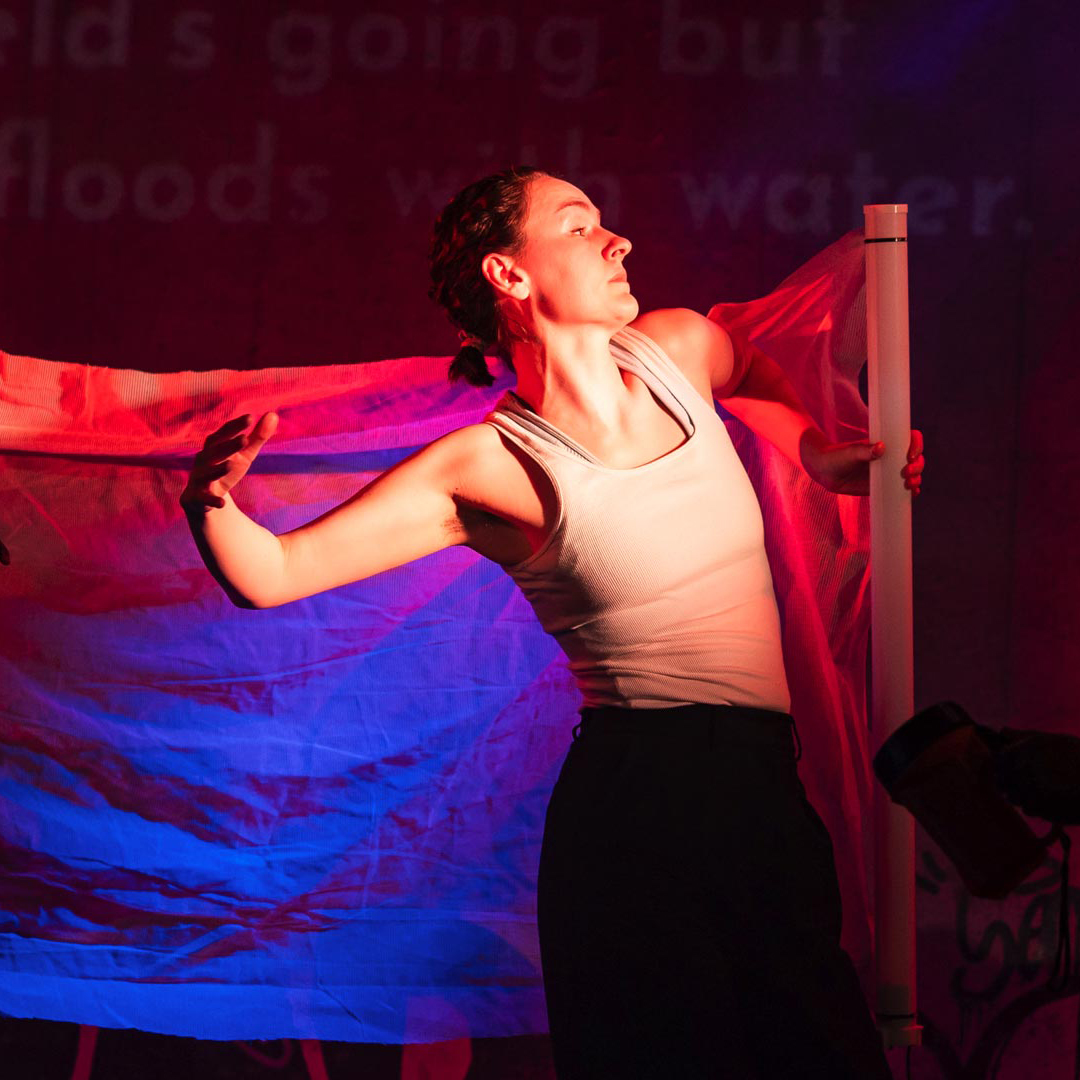
The team blends environmental expertise with arts and cultural sector experience, and the freely available resources constitute the most comprehensive library of good environmental practice developed specifically for the arts and culture sectors anywhere in the world.
If you are an Arts Council England National Portfolio Organisation or Investment Principle Support Organisation, you can record, measure, and track and your environmental action on Julie’s Bicycle Creative Climate Tools (CC Tools), a free carbon calculator designed specifically for the cultural sector. Find out more about reporting your data and the support on offer.
We have also launched a Creative Climate Tools badge to celebrate organisations taking environmental action and encourage you to use it when you share your environmental commitments on your website, social media and email signatures.
LinkedIn, Facebook, X: @JuliesBicycle
Instagram, Threads: @julies_bicycle
Charity registration number: 1153441
Digital Report Design/Development by Splitpixel


